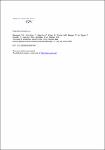The Case of Botulinum Toxin in Milk: Experimental Data
Weingart, Oliver G.
Schreiber, Tanja
Mascher, Conny
Pauly, Diana
Dorner, Martin
Berger, Thomas F. H.
Egger, Charlotte
Gessler, Frank
Loessner, Martin J.
Avondet, Marc-André
Dorner, Brigitte
Botulinum neurotoxin (BoNT) is the most toxic substance known to man and the causative agent of botulism. Due to its high toxicity and the availability of the producing organism Clostridium botulinum, BoNT is regarded as a potential biological warfare agent. Because of the mild pasteurization process, as well as rapid product distribution and consumption, the milk supply chain has long been considered a potential target of a bioterrorist attack. Since, to our knowledge, no empirical data on the inactivation of BoNT in milk during pasteurization are available at this time, we investigated the activities of BoNT type A (BoNT/A) and BoNT/B, as well as their respective complexes, during a laboratory-scale pasteurization process. When we monitored milk alkaline phosphatase activity, which is an industry-accepted parameter of successfully completed pasteurization, our method proved comparable to the industrial process. After heating raw milk spiked with a set amount of BoNT/A or BoNT/B or one of their respective complexes, the structural integrity of the toxin was determined by enzyme-linked immunosorbent assay (ELISA) and its functional activity by mouse bioassay. We demonstrated that standard pasteurization at 72°C for 15 s inactivates at least 99.99% of BoNT/A and BoNT/B and at least 99.5% of their respective complexes. Our results suggest that if BoNTs or their complexes were deliberately released into the milk supply chain, standard pasteurization conditions would reduce their activity much more dramatically than originally anticipated and thus lower the threat level of the widely discussed "BoNT in milk" scenario.
No license information
Related Items
Show related Items with similar Title, Author, Creator or Subject.
-
2016-05-17ZeitschriftenartikelBotulinum Neurotoxin Serotype A Recognizes Its Protein Receptor SV2 by a Different Mechanism than Botulinum Neurotoxin B Synaptotagmin Weisemann, Jasmin; Stern, Daniel; Mahrhold, Stefan; Dorner, Brigitte; Rummel, AndreasBotulinum neurotoxins (BoNTs) exhibit extraordinary potency due to their exquisite neurospecificity, which is achieved by dual binding to complex polysialo-gangliosides and synaptic vesicle proteins. The luminal domain 4 ...
-
2022-02-02ZeitschriftenartikelConstruction and validation of safe Clostridium botulinum Group II surrogate strain producing inactive botulinum neurotoxin type E toxoid Nowakowska, Maria B.; Selby, Katja; Przykopanski, Adina; Krüger, Maren; Krez, Nadja; Dorner, Brigitte G.; Dorner, Martin B.; Jin, Rongsheng; Minton, Nigel P.; Rummel, Andreas; Lindström, MiiaBotulinum neurotoxins (BoNTs), produced by the spore-forming bacterium Clostridium botulinum, cause botulism, a rare but fatal illness affecting humans and animals. Despite causing a life-threatening disease, BoNT is a ...
-
2015-11-26ZeitschriftenartikelQualitative and Quantitative Detection of Botulinum Neurotoxins from Complex Matrices: Results of the First International Proficiency Test Worbs, Sylvia; Fiebig, Uwe; Zeleny, Reinhard; Schimmel, Heinz; Rummel, Andreas; Luginbühl, Werner; Dorner, BrigitteIn the framework of the EU project EQuATox, a first international proficiency test (PT) on the detection and quantification of botulinum neurotoxins (BoNT) was conducted. Sample materials included BoNT serotypes A, B and ...

